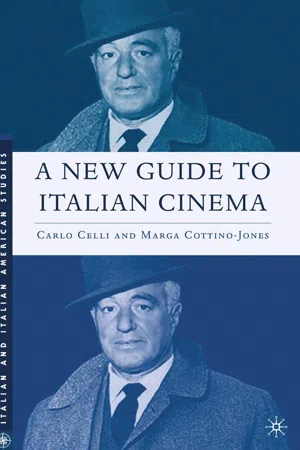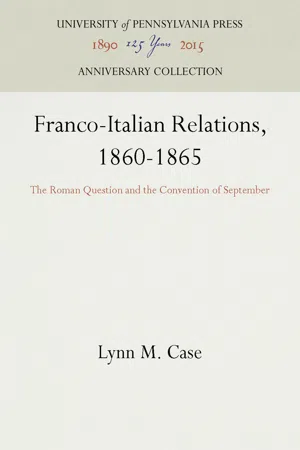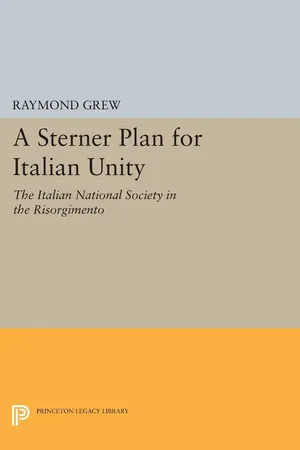History
Unification of Italy
The Unification of Italy refers to the 19th-century process by which the Italian states unified to form the Kingdom of Italy. Led by figures like Giuseppe Garibaldi and Count Camillo di Cavour, this movement aimed to create a single, unified Italian nation-state. The process involved diplomatic maneuvering, military campaigns, and the overthrow of foreign rule in various Italian regions.
Written by Perlego with AI-assistance
Related key terms
1 of 5
7 Key excerpts on "Unification of Italy"
- eBook - PDF
- C. Celli, M. Cottino-Jones(Authors)
- 2007(Publication Date)
- Palgrave Macmillan(Publisher)
1 Italy from Unification to World War I 1860 Giuseppe Garibaldi leads the Spedizione dei Mille (expedition of the thousand) Sicily. Much of southern Italy is annexed by the Kingdom of Piedmont 1866 Annexation of Venice and its territory to the Kingdom of Piedmont after war with Austro-Hungary and Prussia 1870 Rome falls to Piedmontese troops—Unification of Italy complete 1874 Pope Pius IX issues non expedit decree, forbidding Catholics to partici- pate in elections 1876–96 Trasformismo Center left-wing governments 1882 Triple Alliance—Italy merges foreign policy interests with Germany and the Austro-Hungarian Empire after French occupation of Tunis 1896 Italian army defeated at the Battle of Adua, Ethiopia 1900 King Humbert I assassinated by anarchist 1905 Pius X letter Il fermo proposito allowing electoral participation of Catholics with bishop’s permission 1909 F.T. Marinetti’s Futurist Manifesto 1911–12 Libyan War with Turkey (Ottoman Empire) Conquest of Libya and Rhodes 1912 Male suffrage (above age 30 or military service) 1912 Benito Mussolini editor of socialist newspaper Avanti 1915 Italy enters WWI on the side of England, Russia, and France after gain- ing postwar territorial promises in the Pact of London 1917 Austrian breakthrough Italian front at Caporetto 1918 Victory over Austrian army at Vittorio Veneto end of World War I 1919 Italy granted former Austrian possessions at Versailles peace conference Fascist movement first organized Gabriele D’Annunzio decries the pace mutilata (mutilated peace) over the lack of territorial concessions in Dalmatia and Istria, occupies Fiume (contemporary Rjecka) I taly as a nation is relatively young, only achieving total unification in 1870. In fact, the country has been more often described as a geographical rather than cultural entity. 1 Politically, Italy consisted of a collection of small feudal heredi- tary principalities whose history dates back to the early Middle Ages. - No longer available |Learn more
- (Author)
- 2014(Publication Date)
- University Publications(Publisher)
________________________ WORLD TECHNOLOGIES ________________________ Chapter 2 Italian Unification Italian unification (Italian: il Risorgimento , or The Resurgence ) was the political and social movement that agglomerated different states of the Italian peninsula into the single state of Italy in the 19th century. Despite a lack of consensus on the exact dates for the beginning and end of this period, many scholars agree that the process began in 1815 with the Congress of Vienna and the end of Napoleonic rule, and ended sometime around 1871 with the Franco-Prussian War. The last città irredente however, did not join the Kingdom of Italy until after World War I. Background Italian unification process As Napoleon's reign began to fail, other national monarchs he had installed tried to keep their thrones by feeding nationalistic sentiments, setting the stage for the revolutions to come. Among these monarchs were the viceroy of Italy, Eugène de Beauharnais, who tried to get Austrian approval for his succession to the Kingdom of Italy, and Joachim Murat, who called for Italian patriots' help for the Unification of Italy under his rule. Following the defeat of Napoleonic France, the Congress of Vienna (1815) was convened to redraw the European continent. In Italy, the Congress restored the pre-Napoleonic ________________________ WORLD TECHNOLOGIES ________________________ patchwork of independent governments, either directly ruled or strongly influenced by the prevailing European powers, particularly Austria. At the time, the struggle for Italian unification was perceived to be waged primarily against the Austrian Empire and the Habsburgs, since they directly controlled the predominantly Italian-speaking northeastern part of present-day Italy and were, together, the most powerful force against unification. The Austrian Empire vigorously repressed nationalist sentiment growing on the Italian peninsula, as well as in the other parts of Habsburg domains. - eBook - PDF
Franco-Italian Relations, 1860-1865
The Roman Question and the Convention of September
- Lynn M. Case(Author)
- 2016(Publication Date)
C H A P T E R I FRANCE AND ITALY'S UNIFICATION IN 1860 r T E R many attempts and failures the national movement toward Italian unification which had received its encour-agement during the days of the First Empire was beginning to show some definite results in the second half of the nineteenth century. In 1821 Austria intervened by force and restored ab-solutist regimes in both Naples and Piedmont where constitu-tional governments had been granted after revolutionary up-risings. In 1831 revolts broke out anew, this time in the Papal States, Parma, and Modena. Austria intervened again and suc-cessfully restored the old order. However, on this occasion France under Louis Philippe, opposing the policy of foreign intervention, but more especially jealous of Austrian predomi-nance in Italy, sent troops to Ancona under the double guise of friendship for the Liberals and as a protection to the Pope's person. The French force was withdrawn in 1838. The liberal and nationalistic spirit of revolt was not indeed killed in Italy. It needed only the news of the fall of Louis Philippe in France and Metternich in Austria in 1848 in order to spur the Italians on to form a united constitutional state by force. This time the whole Peninsula rose in unison: Lombardy, Venice, Piedmont, the Central States, and Naples. Even the Pope himself, Pius I X , at that time more liberal in his attitude, joined the movement to drive the Austrians from Italian soil. But this Italian revolt of the spring of 1848 was put down by the Austrian forces under Radetzky after the Pope had with-drawn his support. Later, however, in the autumn of 1848 revolts of a more republican character broke out again in Italy. This time the Italians turned against Pius I X , drove him from Rome, and established the Roman Republic under Garibaldi and Mazzini. Still this more radical revolution had even less success. The 3 - eBook - ePub
- James Robinson, Charles Beard(Authors)
- 2017(Publication Date)
- Jovian Press(Publisher)
THE Unification of Italy
~ CAVOUR AND ITALIAN UNITYThe efforts of the Italian liberals to expel Austria from the peninsula and establish constitutional governments in the various Italian states had failed, and after the battle of Novara it seemed as if the former political conditions were to be restored. The king of Naples broke all the promises which he had made to his subjects, revoked the constitution which he had granted, and imprisoned, exiled, or in some cases executed the revolutionists. The Pope, with the assistance of France, Austria, Naples, and Spain, was able to destroy the Roman Republic which had been set up, and place the government again in the hands of the ecclesiastics. In northern Italy Austria was once more in control, and she found faithful adherents in the rulers of Modena, Parma, and Tuscany, who looked to her for continued support. The leading spirits of the revolution who had escaped prison or death fled to foreign countries to await a more auspicious opportunity to secure their ends, for they did not surrender the hope that Austria would sometime be driven from their country, and all the Italian states brought together into a federation, or perhaps united into a single monarchy or republic.However, those who, since the fall of Napoleon I, had been interested in promoting Italian independence and liberty differed from one another as to the best way in which to make Italy a nation. There were the republicans, who became more and more disgusted with monarchy and believed that nothing could be accomplished until the various rulers should give way to a great democratic republic, which should recall the ancient glories of Rome; others were confident that an enlightened Pope could form an Italian federation, of which he should be the head; lastly, there was a practical party, whose adherents placed their hopes in the king of Sardinia, who seemed to them to be the natural leader in the emancipation of Italy. Little as the revolution of 1848 had accomplished, it had at least given Sardinia a young and energetic king and a new constitution. - eBook - ePub
- Joshua Whatmough(Author)
- 2015(Publication Date)
- Routledge(Publisher)
CHAPTER XVIII THE Unification of Italy 1. THE DIVERSITY OF PEOPLES AND CULTURES H ITHERTO we have been occupied with the prehistory of the several fractions of a land that was and is a geographical unity. It remains to enquire how they came to be united politically also, so that when a united Italy had been set up on those ancient foundations it might become in its turn one of the most important foundation-stones of western civilization. The disunion of pre-Roman Italy, except in the geographical sense, is too obvious to need emphasis. For though the land itself makes an entity, and a self-contained entity at that, it was occupied by the representatives of more than one primitive society, 1 each of which had its own type of civilization, and each of which (with a single exception) had, once it was established in Italy, lost touch with other branches of the same society without establishing, except after a delay of several centuries, effective contact with the other societies that were its neighbours within the peninsula. The one exception is the Hellenic society, which in ancient Italy never really lost touch with its own centre, with the source from which it had sprung. The extremely ancient neolithic civilization (we can hardly speak of it as a society) belonged to a very sparse and scattered population in Italy, the elements of which can have had no sort of unity either within themselves or with other neolithic peoples. The later bronze age and early iron age peoples likewise not only were detached almost as completely from their central European and Danubian homelands as if the ocean flowed between, but also formed in their new home quasi-national groups that were divorced from one another in everything except trading relations that were always liable to interruption, were always conducted on a small scale, judged by the international trade even of Roman times, and in no case tended to produce a union of two or more groups - eBook - PDF
- Raymond Grew(Author)
- 2015(Publication Date)
- Princeton University Press(Publisher)
After generations of nationalist agitators and writers, it was too natural an assumption to need further debate; Mazzini had done his work too well. Italy was conceived of as a geographical entity which, although less diverse than England, France, or Germany, had lost its independence. 3 A common language, common customs, religion, and interests—these were points used only to prove the obvious to peasants or foreigners.* There was little further consideration of the nature of a nation or the role of the state in European society. Garibaldi had recog- nized their aim as being that of Dante, Petrarch, and Machia- velli; 5 a concept with such roots needed no defense. The first task, then, of the Society's propaganda was to prove that under present conditions unification was both a possible step and the necessary one for the realization of other goals. The Piemonte saw in such a dream the "castles in air" of another sect, and the Opinione viewed it as Utopian. Tommaseo sus- pected this too was another romanza; Cavour's doubts are fam- ous. 6 The Society sought to meet such skepticism—and this, too, is typical of its temper—not with theoretical statements but 1 Giuseppe La Farina, Sicilia e Piemonte (Turin, n.d. [1857]), 1. This pam- phlet appeared under the label of the PNI. 2 [Pallavicino], "Programme della Societa Nazionale Italiana" (always printed with the Credo). 8 [La Farina], Credo Politico della Societa Nazionale Italiana (Turin, 1858), 7, 20. * [Biagio Caranti], Catechismo politico pet contadini piemontesi (Turin, 1858), 11; article in the North British Review, February 1856, as printed in Maineri, Manin e Pallavicino, 550. - eBook - PDF
The Risorgimento Revisited
Nationalism and Culture in Nineteenth-Century Italy
- S. Patriarca, L. Riall, S. Patriarca, L. Riall(Authors)
- 2011(Publication Date)
- Palgrave Macmillan(Publisher)
21 If cultural-history approaches have been dominant so far, the new history of the Risorgimento has not been limited to them. In fact, the revisiting of the Risorgimento has concerned also the political and social history of the period, 22 and it has produced innovative examples of integration between socio-political history and cultural history. Lucy Riall’s study of the ‘inven- tion’ of Garibaldi has firmly placed the cultural aspects of this phenomenon within the political events and the social context of the period: Garibaldi’s fame, she argues, was the result of a political strategy to make visible, con- vincing and more popular an otherwise restricted sense of Italian cultural identity. Riall has also stressed the material bases of the process. She points to the importance of the revolution in print culture and the growth of a broad reading public, and above all the mass production and circulation of illustrated magazines and newspapers. It was this phenomenon that under- wrote the popularization of the figure of Garibaldi among a growing mid- dle-class public of men and women, who were thirsty for information about exciting events and romantic heroes. 23 The building of nations is a process that takes place across state boundaries, and Italy is no exception. What Alberto Banti has called the Risorgimento literary canon – that is, the texts that most influenced the supporters of the national cause – included also works written by non-Italians, such as the Swiss historian and political economist J.-C.-L. Simonde de Sismondi, the author of a history of the free communes in the Middle Ages that greatly inspired Italian patriots. In her study of the ‘romance of Italy’ in Victorian Britain, Maura O’Connor has shown how the popularity of the Italian cause was put to use by the British liberal classes in the process of their own self- fashioning.
Index pages curate the most relevant extracts from our library of academic textbooks. They’ve been created using an in-house natural language model (NLM), each adding context and meaning to key research topics.






